Effect of Structural Funds on Housing Market Sustainability Development—Correlation, Regression and Wavelet Coherence Analysis
Abstract
1. Introduction
2. Literature Review
2.1. Evolution and Concepts Applied in Research: Development, Region, Regional Development, Sustainable Development, Smart Development, including Smart Specializations
2.2. Real Estate Market and Its Impact on the Economy
2.3. ROP Payments and Their Impact on the Economy
3. Analysis of the Effect of Operating Programs on Selected Determinants of Housing Market Development
3.1. Data and Methods
- (a)
- Analysis of time variability of investigated determinants vs. payments made within the framework of the ROP OV. The functional analysis was performed by applying common multiple regression principles according to the assumption that theoretical values of the variable can be recorded in matrix form (cf. Equation (1)).
- (b)
- Analysis of correlations between investigated determinants and payments incurred within the framework of the ROP OV. This analysis was performed using the Pearson linear correlation, assuming that x and y form the investigated random variables with discrete distributions. The terms and denote the values of random samples of these variables (i = 1, 2, …, n) and (i = 1, 2, …, n), while and represent the mean values of these samples. Consequently, the linear correlation coefficient estimator was determined on the basis of Equation (3).
- (c)
- Coherence analysis for investigated dimensions. Wavelet coherence analysis constitutes a measure of the correlation between two signals in the time-frequency domain. Wavelet coherence finds application in the analysis of non-stationary signals and offers the means for identification of cycle synchronization. From the point of view of applied computational engineering, coherence was derived by application of the analytical Morlet wavelet. A useful tip that serves the purposes of the analysis of periodicity synchronization in the examined variables involves the possibility of investigating the directions of arrows representing phase distributions. The goal of wavelet coherence analysis first of all involves the determination of wavelet cross-spectrum, which forms a measure of the distribution of two signals. This spectrum of two time series takes the form given by Equation (4).
3.2. Results and Discussion
- annual and 18-month-cycles occur in a counter-phase,
- semi-annual cycle occurs in-phase and forms a preceding cycle.
4. Conclusions
4.1. Conclusions of the Study
- In the quantitative analysis of the investigated relations, the process of building regression models was performed, the structural form of which is presented in Figure 4 and Figure 5. The graphs illustrate the following relations: on average an increase of payments made under the ROP OV by PLN 1 million, leads to an increase in the granted permits by 1.29. In the case of dwellings under construction, we can note an increase of 0.331. The higher value of the ratio of building permits demonstrates that this economic variable is more flexible (and sensitive to variations in the external factors) compared to the case of the number of dwellings under construction.
- In the process of assessment of the significant time delays between the examined variables, granted building permits are characterized by a greater degree of variations in comparison to data for dwellings under construction. For building permits, there is a 3-month delay compared to the ROP OV payments, for apartments under construction the delay is 6 months (see Figure 6 and Figure 7).
- The final stage of the research involved the assessment of the correlation and synchronization of any periodicity. The study conducted an analysis of the wavelet coherence between the established relations. For the wavelet coherence shown in Figure 8, i.e., for data between granted permits and payments made, there is a linear correlation for the bi-annual cycle in 2016–2018 and in 2019. We can also note that in the years 2016–2020 there is a linear relationship between the annual and 18-month cycles in the analyzed example. When the synchronization for the identified cyclicity is described, it can be noted that: the annual cycle and the 18-month cycle occur in a counter-phase, and the bi-annual cycle forms a cycle that occurs in phase and represents a leading cycle.
- From the analysis of the linear correlation of cyclicity and the analysis of the course of wavelet coherence performed for dwellings under construction (Figure 9), it can be concluded that the dominant cyclical relations can be established with regard to the annual cycle, which is a cycle delayed in counter-phase. This cycle occurred in 2016–2020. It should also be noted that in 2017–2019 there is a linear relationship between semi-annual and two-year cycle.
4.2. Summary of Findings
- The determination of the principles for implementing the operational program should be the subject of discussions and meetings with program stakeholders. This approach guarantees greater efficiency in distributing funds.
- The evaluation of the pace of spending EU funds, i.e., payments from the operational program, should be monitored on an ongoing basis in order to to introduce corrective measures early. The applied correction actions should be based on the review of past experiences.
- At the level of implementing project initiatives funded from EU sources, information activities should be performed to promote the fastest possible implementation of projects.
Author Contributions
Funding
Data Availability Statement
Conflicts of Interest
| 1 | Interpretation: If arrows point up, an investigated variable A precedes variable B for the relation expressed by A–B in the chart and if they point down, the circumstances are reversed; horizontal arrows directed right inform of processes that occur in-phase, i.e., courses of cycles that overlap, horizontal arrows directed left inform of “counter-phase”, i.e., an overlap of peaks within a single process occurs, with instances representing valleys in the cycle in the second process. |
References
- Antonescu, Daniela. 2014. Regional Development Policy in Context of Europe 2020 Strategy. Procedia Economics and Finance 15: 1091–97. [Google Scholar] [CrossRef][Green Version]
- Augustyniak, Hanna, Krzysztof Olszewski, and Krzysztof Gajewski. 2011. Informacja o cenach mieszkań i sytuacji na rynku nieruchomości mieszkaniowych i komercyjnych w Polsce 1 w II kwartale 2011 r. Available online: https://www.nbp.pl/publikacje/rynek_nieruchomosci/ceny_mieszkan_06_2011.pdf (accessed on 24 September 2021).
- Balemi, Nadia, Roland Füss, and Alois Weigand. 2021. COVID-19’s impact on real estate markets: Review and outlook. Financial Markets and Portfolio Management, 1–19. [Google Scholar] [CrossRef]
- Banaszewska, Monika, and Ivo Bischoff. 2021. Grants-in-aid and election outcomes in recipient jurisdictions: The impact of EU funds on mayoral elections in Poland. European Journal of Political Economy 68: 101993. [Google Scholar] [CrossRef]
- Barbier, Edward B., Anil Markandya, and David W. Pearce. 1990. Environmental Sustainability and Cost-Benefit Analysis. Environment and Planning A 2: 1259–66. [Google Scholar] [CrossRef]
- Barca, Fabrizio, Philip McCann, and Andrés Rodríguez-Pose. 2012. The case for Regional Development Intervention: Place-Based Versus Place-Natural Approaches. Journal of Regional Science 52: 134–52. [Google Scholar] [CrossRef]
- Barska, Anetta, Janina Jędrzejczak-Gas, Joanna Wyrwa, and Krzysztof Kononowicz. 2020. Multidimensional Assessment of the Social Development of EU Countries in the Context of Implementing the Concept of Sustainable Development. Sustainability 12: 7821. [Google Scholar] [CrossRef]
- Batrancea, Ioan, Larissa Batrancea, Anca Nichita, Lucian Gaban, Ema Masca, Ioan-Dan Morar, Gheorghe Fatacean, and Andrei Moscviciov. 2019. An econometric approach on production, costs and profit in Romanian coal mining enterprises. Economic Research-Ekonomska Istraživanja 32: 1019–36. [Google Scholar] [CrossRef]
- BDL. n.d. Statistics Office Poland. Available online: https://bdl.stat.gov.pl/BDL/start (accessed on 12 December 2020).
- Bedrunka, Karina. 2015. Specjalizacje regionalne jako baza do podnoszenia poziomu innowacyjności w województwie opolskim (Regional specializations as a base for increasing the level of innovation in the Opolskie Voivodeship). In Efektywny transfer wiedzy z nauki do przemysłu w województwie opolskim. Edited by K. Malik and Ł. Dymek. Warszawa: Wydawnictwo Difin, pp. 70–79. [Google Scholar]
- Bedrunka, Karina. 2020. Concepts of the Sustainable Development of the Region. In Sustainable production: Novel Trends in Energy, Environmental and Materials Systems. Edited by Grzegorz M. Królczyk, Małgorzata Wzorek, Anna Król, Orest Kochan, Jun Su and Janusz Kacprzyk. Berlin: Springer, pp. 11–18. [Google Scholar]
- Bedrunka, Karina, and Łukasz Dymek. 2016. Pojęcie regionu i znaczenie jego rozwoju (The concept of the region and the importance of its development). In Ekonomia: Przewodnik dla studentów i doktorantów kierunków technicznych. Edited by Krzysztof Malik. Opole: Politechnika Opolska, pp. 101–10. [Google Scholar]
- Bedrunka, Karina, and Krzysztof Malik. 2012. Zintegrowana efektywność polityki rozwoju regionalnego w kolejnym okresie programowania 2014–2020 (Integrated Efficiency and Effectiveness of the 2014–2020 Regional Development Policy Perspective). Hndel Wewnętrzny: Trendy i Wyzwania Zrównoważonego Rozwoju w XXI Wieku II: 7–18. [Google Scholar]
- Bedrunka, Karina, and Krzysztof Malik, eds. 2014. Sustainable development as a criterion for eveluating the integrated implementation of the regional development policy. In Multi-Dimensional Effectivenessof Regional Development Policy. Implementation: Evaluation Scheme for the Opole Voivodeship. Warszawa: Polish Academy for Sciences Committee for Spatial Economy and Regional Planning, p. 168. ISBN 978-83-63563-73-8. [Google Scholar]
- Bedrunka, Karina, Łukasz Mach, Anna Kuczuk, and Anna Bohdan. 2021. Identification and Analysis of Structural Fund Support Mitigating the Effects of the COVID-19 Pandemic in the EU—A Case Study of Health Unit Funding. Energies 14: 4976. [Google Scholar] [CrossRef]
- Biela, Adam. 2001. Metodologia wyceny kapitału ludzkiego w kontekście koncepcji zrównoważonego rozwoju. In Ekonomia a rozwój zrównoważony, tom 1—Teoria i Kształcenie. Edited by Franciszek Piontek. Białystok: Wydawnictwo Ekonomia i Środowisko, pp. 207–28. [Google Scholar]
- Boin, Arjen, Martin Lodge, and Marte Luesink. 2020. Learning from the COVID-19 crisis: An initial analysis of national responses. Policy Design and Practice 3: 189–204. [Google Scholar] [CrossRef]
- Borys, Tadeusz. 2001. Jakość życia a zrównoważony rozwój. Relacja i pomiar. In Ekonomia a rozwój zrównoważony. Teoria i kształcenie. Edited by Franciszek Piontek. Białystok: Wydawnictwo Ekonomia i Środowisko, chp. 1. p. 81. [Google Scholar]
- Borys, Tadeusz. 2005. Wskaźniki zrównoważonego rozwoju. Białystok: Wydawnictwo Ekonomia i Środowisko. [Google Scholar]
- Cardenete, Manuel Alejandro, and M. Carmen Delgado. 2015. A simulation of impact of withdrawal European funds on Andalusian economy using a dynamic CGE model: 2014–20. Economic Modelling 45: 83–92. [Google Scholar] [CrossRef]
- Chądzyński, Jacek, Aleksandra Nowakowska, and Zbigniew Przygodzki. 2012. Region i jego rozwój w warunkach globalizacji (The Region and Its Development in the Conditions of Globalization). Warszawa: Wydawnictwo Fachowe, CeDEWu.pl, pp. 1–252. [Google Scholar]
- Chłoń-Domińczak, Agnieszka, Irena E. Kotowska, Jolanta Kurkiewicz, Marcin Stonawski, and Anita Abramowska-Kmon. 2014. Population Ageing in Europe: Facts, Implications and Policies. Brussels: Outcomes of EU-Funded Research. European Commision—Research and Innovation. European Union, pp. 1–77. [Google Scholar] [CrossRef]
- Crescenzi, Riccardo, Marco Di Cataldo, and Mara Giua. 2019. LSE “Europe in Question”. Discussion Paper Series It’s Not about the Money! EU FUNDS, Local Opportunities, and the Brexit Vote. 2019, LEQS Paper No. 149/2019. Available online: http://www.lse.ac.uk/european-institute/research/leqs-discussion-paper-series (accessed on 24 September 2021).
- Croom, Brandon, Sean Kennedy, Sandesh Ojha, and Justin Sparks. 2020. Analysis of the Commercial Real Estate Market in a post COVID-19 World. SMU Data Science Review 3: 5. Available online: https://scholar.smu.edu/datasciencereview/vol3/iss3/5 (accessed on 4 October 2021).
- Cunico, Giovanni, Eirini Aivazidou, and Edoardo Mollona. 2021. Beyond financial proxies in Cohesion Policy inputs’ monitoring: A system dynamics approach. Evaluation and Program Planning 89: 101964. [Google Scholar] [CrossRef]
- Czaja, Stanisław. 1992. Entropijno-energetyczna analiza procesów gospodarczych. Kierunki rozwoju analizy energetycznej (The Entropic and Energetic Analysis of Economic Processes. The Development Directions of the Energetic Analysis). Ekonomia i Środowisko 2: 9–20. [Google Scholar]
- De Toro, Pasquale, Francesca Nocca, and Francesca Buglione. 2021. Real Estate Market Responses to the COVID-19 Crisis: Which Prospects for the Metropolitan Area of Naples (Italy)? Urban Science 5: 23. [Google Scholar] [CrossRef]
- Dell’Ariccia, Giovanni, Pau Rabanal, Christopher Crowe, and Deniz Igan. 2021. Cover Staff Discussion Notes Policies for Macrofinancial Stability: Options to Deal with Real Estate Booms. Journal of Financial Stability 2011: 2–33. [Google Scholar]
- Di Mauro, Filippo, Stephane Dees, and Warwick J. McKibbin. 2010. Regionalism and Economic Interdependence. Cambridge: Cambridge University Press, pp. 1–182. [Google Scholar]
- Dziedzic, Sylwia, Leszek Woźniak, and Maciej Chrzanowski. 2015. Inteligentne specjalizacje jako droga dla zrównoważonego rozwoju (Smart specializations as a path for sustainable development). In Zrównoważony rozwój organizacji-odpowiedzialność środowiskowa. Edited by Tadeusz Borys, Bartosz Bartniczak and Michał Ptak. Wrocław: Wydawnictwo Naukowe Uniwersytetu Ekonomicznego, vol. 377, pp. 267–79. [Google Scholar]
- El Serafy, Salah. 1991. The environment as capital. In Ecological Economics: The Science and Management of Sustainability. Edited by Robert Costanza. New York: Columbia University Press, pp. 168–75. [Google Scholar]
- European Commission. 2021. Available online: https://ec.europa.eu/eurostat/web/products-eurostat-news/-/ddn-20210303-1 (accessed on 12 December 2020).
- European Commission. 2010a. Commission Staff Working Document Document accompanying the Commission Communication on Regional Policy Contributing to Smart Growth in Europe 2020. Brussels, Belgium. Available online: https://ec.europa.eu/regional_policy/sources/docoffic/official/communic/smart_growth/annex_comm2010_553.pdf (accessed on 10 January 2021).
- European Commission. 2010b. Europe 2020 Communination from the Commission, Europe 2020. A Strategy for Smart, Sustainable and Inclusive Growth. Brussels, Belgium. Available online: https://eur-lex.europa.eu/legal-content/EN/TXT/PDF/?uri=CELEX:52010DC2020&from=PL (accessed on 10 January 2021).
- Foray, Dominique, Paul A. David, and Bronwyn H. Hall. 2011. Smart specialization—From academic idea to political instrument, the surprising career of a concept and the difficulties involved in its implementation. In Working Paper Series, Management of Technology and Entrepreneurship Institute. Lausanne: College of Management of Technology, pp. 1–16. [Google Scholar]
- Foray, Dominique, and Xabier Goenaga. 2013. The Goals of Smart Specialisation. In JRC Scientific and Policy Reports. S3 Policy Brief Series. Luxembourg: Publications Office of the European Union, vol. 1, pp. 1–14. [Google Scholar]
- Foray, Dominique, Kevin Morgan, and Slavo Radosevic. 2018. The Role of Smart Specialisation in the EU Research and Innovation Policy Landscape. European Commission—Regional and Urban Policy 1–20. Available online: https://ec.europa.eu (accessed on 10 January 2021).
- Iuga, Iulia Cristina, and Anastasia Mihalciuc. 2020. Major Crises of the XXIst Century and Impact on Economic Growth. Sustainability 12: 9373. [Google Scholar] [CrossRef]
- JLL Research & Strategy. 2020. COVID-19: Global Real Estate Implications, Paper II. Hillsborough: Global Research, April 20, Available online: https://www.jll.it/it/tendenze-e-ricerca/research/covid-19-global-real-estate-implications (accessed on 4 October 2021).
- Kangas, Riikka, and Timo Aarrevaara. 2020. Higher Education Institutions as Knowledge Brokers in Smart Specialisation. Sustainability 12: 3044. [Google Scholar] [CrossRef]
- Klasik, Andrzej. 2006. Przedsiębiorczość i konkurencyjność a rozwój regionalny—Wprowadzenie (Entrepreneurship and competitiveness versus regional development—Introduction). In Przedsiębiorczość i konkurencyjność a rozwój regionalny. Edited by A. Klasik. Katowice: Prace Naukowe, Akademia Ekonomiczna w Katowicach, pp. 15–58. [Google Scholar]
- Kudłacz, Tadeusz. 1999. Programowanie Rozwoju Regionalnego (Programming of Regional Development). Warszawa: PWN, pp. 1–180. [Google Scholar]
- Lafuente, Juan Ángel, Amparo Marco, Mercedes Monfort, and Javier Ordóñez. 2020. Social Exclusion and Convergence in the EU: An Assessment of the Europe 2020 Strategy. Sustainability 12: 1843. [Google Scholar] [CrossRef]
- Mach, Łukasz. 2021. Analiza Zmienności czasowo-częstotliwoścowej rynku budonictwa mieszkaniowego. Warszawa: SGH w Warszawie. [Google Scholar]
- Malik, Krzysztof. 2011. Ewaluacja polityki rozwoju regionu. Metody, konteksty i wymiary rozwoju zrównoważonego (Evaluation of regional development policy: Methods, contexts and dimensions of sustainable development). Studia Komitet Przestrzennego Zagospodarowania Kraju PAN 135: 3–187. [Google Scholar]
- Mayer-Stamer, Jörg. 2016. Systemic Competitiveness and Local Economic Development. In Large Systemic Change: Theories, Modelling and Practices. Edited by Shamim Bodhanya. Duisburg: Meso Partner, chp. 11. [Google Scholar]
- Mazur-Wierzbicka, Ewa. 2015. Wzrost sprzyjający włączeniu społecznemu jako wyzwanie dla Polski w świetle Strategii Europa 2020 (Inclusive growth as a challenge for Poland in the light of the Europe 2020 Strategy). Studia Ekonomiczne, Zeszyty Naukowe Uniwersytetu Ekonomicznego 213: 69–184. [Google Scholar]
- Nowakowska, Aleksandra. 2015. Budowanie inteligentnych specjalizacji—Doświadczenia i dylematy polskich regionów (Building smart specializations—Experiences and dilemmas of Polish regions). Studia Prawno-Ekonomiczne XCVII: 325–40. [Google Scholar]
- OECD. n.d. Regional Development Policy. Source Details. Available online: http://www.oecd.org/regional/regionaldevelopment.htm (accessed on 6 November 2020).
- Ponsiglione, Cristina, Ivana Quinto, and Giuseppe Zollo. 2018. Regional Innovation Systems as Complex Adaptive Systems: The Case of Lagging European Regions. Sustainability 10: 2862. [Google Scholar] [CrossRef]
- Radulescu, Magdalena, Aleksandra Fedajev, Crenguta Ileana Sinisi, Constanta Popescu, and Silvia Elena Iacob. 2018. Europe 2020 Implementation as Driver of Economic Performance and Competitiveness. Panel Analysis of CEE Countries. Sustainability 10: 566. [Google Scholar] [CrossRef]
- Schmidhuber, J., and B. Qiao. 2020. Comparing Crises: Great Lockdown versus Great Recession. Rome, Italy: FAO. [Google Scholar]
- Širá, Elena, Roman Vavrek, Ivana Kravčáková Vozárová, and Rastislav Kotulič. 2020. Knowledge Economy Indicators and Their Impact on the Sustainable Competitiveness of the EU Countries. Sustainability 12: 4172. [Google Scholar] [CrossRef]
- Stawasz, D. 2004. Gospodarka regionalna—Teoria i praktyka (Regional economy—theory and practice). In Ekonomiczne i organizacyjne uwarunkowania rozwoju regionu-teoria i praktyka. Edited by D. Stawasz. Łódź: Wydawnictwo Uniwersytetu Łódzkiego. [Google Scholar]
- Szlachta, Jacek. 1996. Główne problemy polityki rozwoju regionalnego Polski na przełomie XX i XXI wieku (Main problems of the Polish regional development policy at the turn of the 20th and 21st centuries). In Strategiczne wyzwania dla polityki rozwoju regionalnego Polski. Edited by Ryszard Broszkiewicz. Warszawa: Friedrich-Ebert-Stiftung-Przedstawicielstwo w Polsce. [Google Scholar]
- Sztando, Andrzej. 1998. Oddziaływanie samorządu lokalnego na rozwój lokalny w świetle ewolucji modeli ustrojowych gmin (The impact of local government on local development in the light of the evolution of system models in communes). Samorząd Terytorialny 11: 12–29. [Google Scholar]
- Tomer, John F. 1987. Organizational Capital: The Path to Higher Productivity and Well-Being Praeger. Journal of Economic Behavior and Organization 11: 453–55. [Google Scholar]
- Zalewska, Mariola E., and Piotr Świetlikowski. 2017. Ocena szans realizacji głównych celów Strategii Europa 2020 w krajach grupy wyszehradzkiej (Assessment of the chances of achieving the main goals of the Europe 2020 Strategy in the countries of the Visegrad group). Zeszyty Naukowe Politechniki Śląskiej. Seria: Organizacja i Zarządzanie 104: 367–78. [Google Scholar]
- Zarząd Województwa Opolskiego. 2014. Regionalna Straregia Innowacji Województwa Opolskiego do 2020 roku. Available online: https://rpo.opolskie.pl/wp-content/uploads/Regionalna_Strategia_Innowacji_Wojew%C3%B3dztwa_Opolskiego_do_roku_2020.pdf (accessed on 12 November 2020).
- Zhang, Dayong, Jing Cai, Jia Liu, and Ali M. Kutan. 2018. Real estate investments and financial stability: Evidence from regional commercial banks in China. The European Journal of Finance 24: 1388–408. [Google Scholar] [CrossRef]

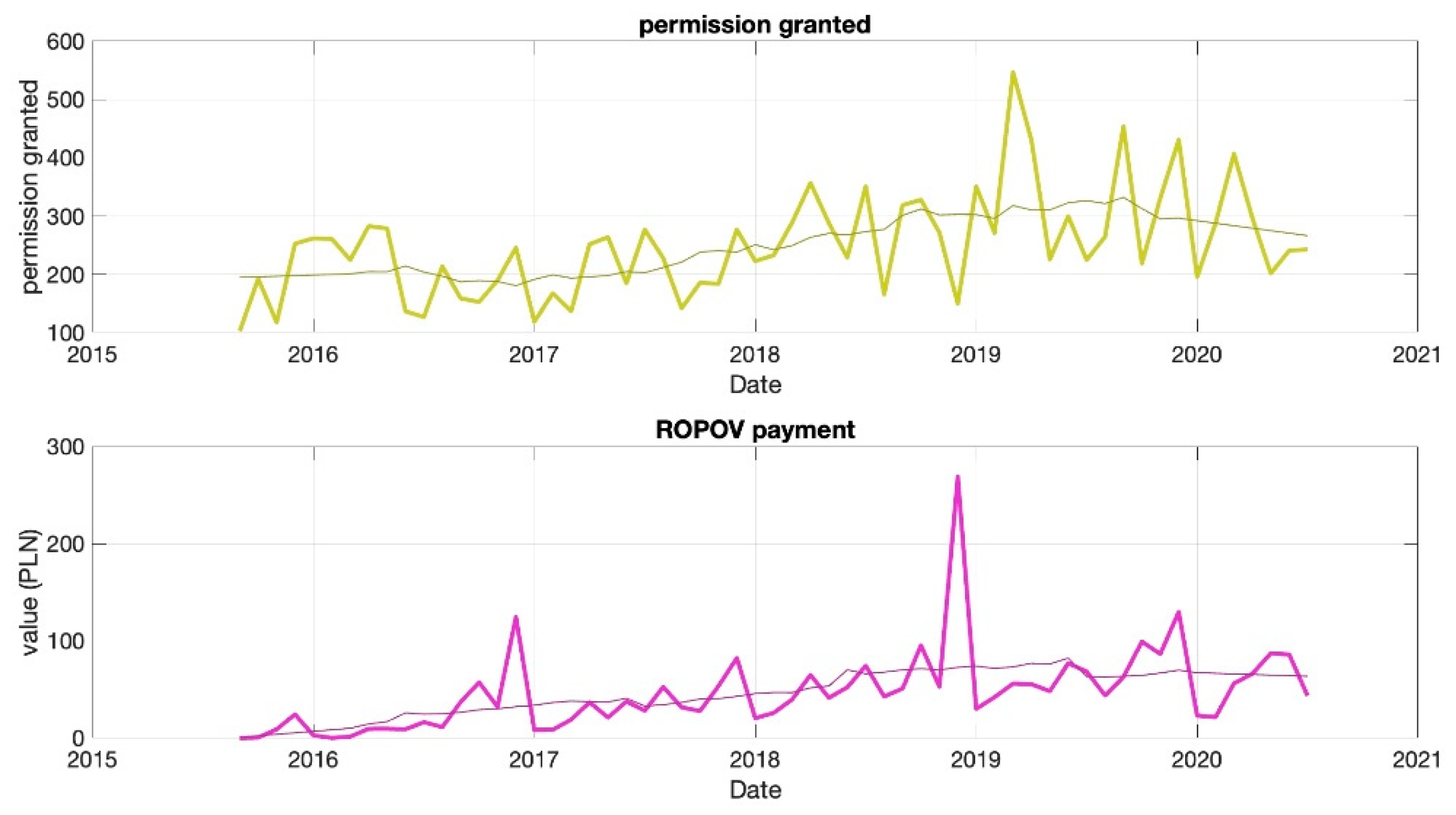
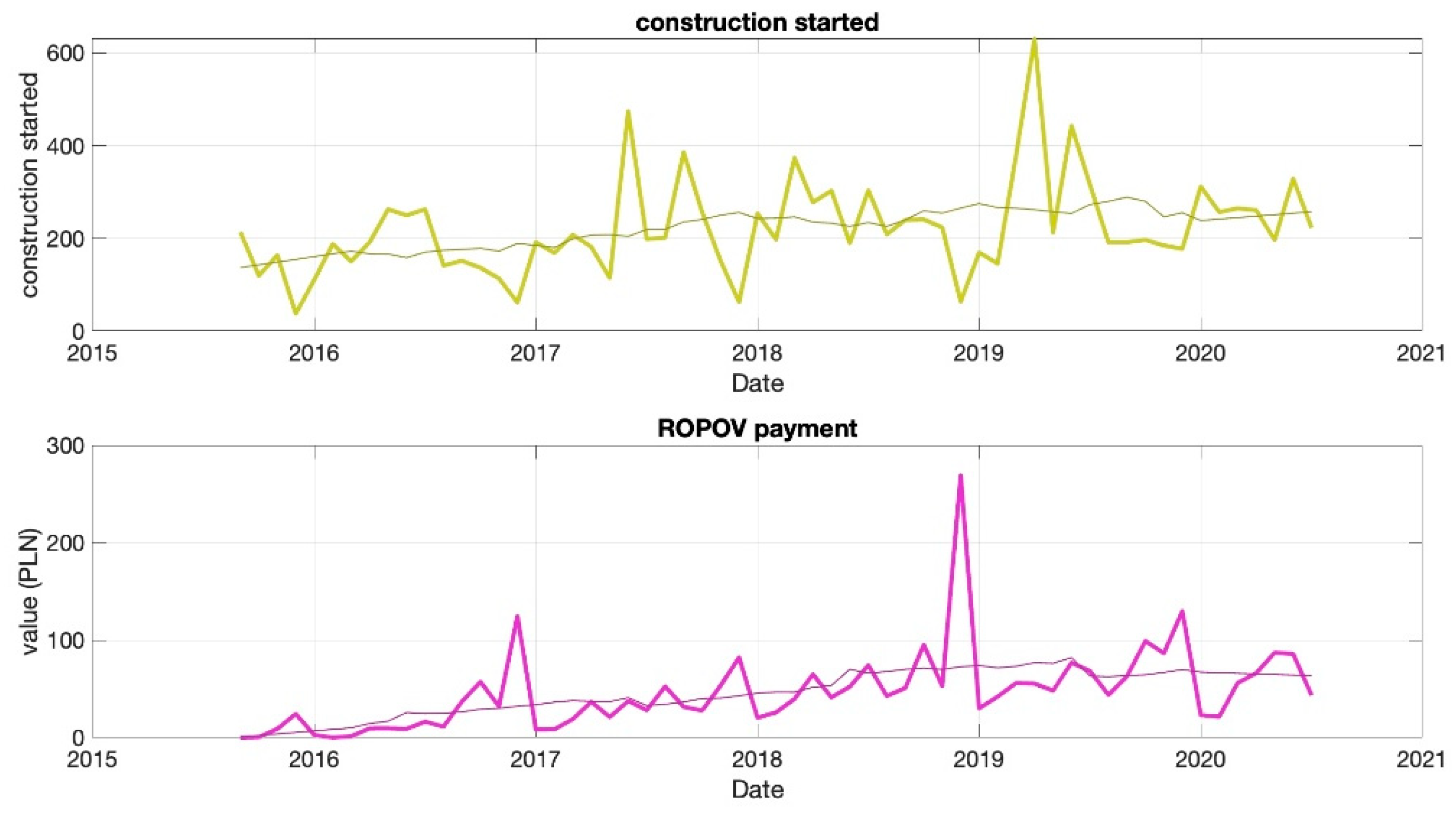
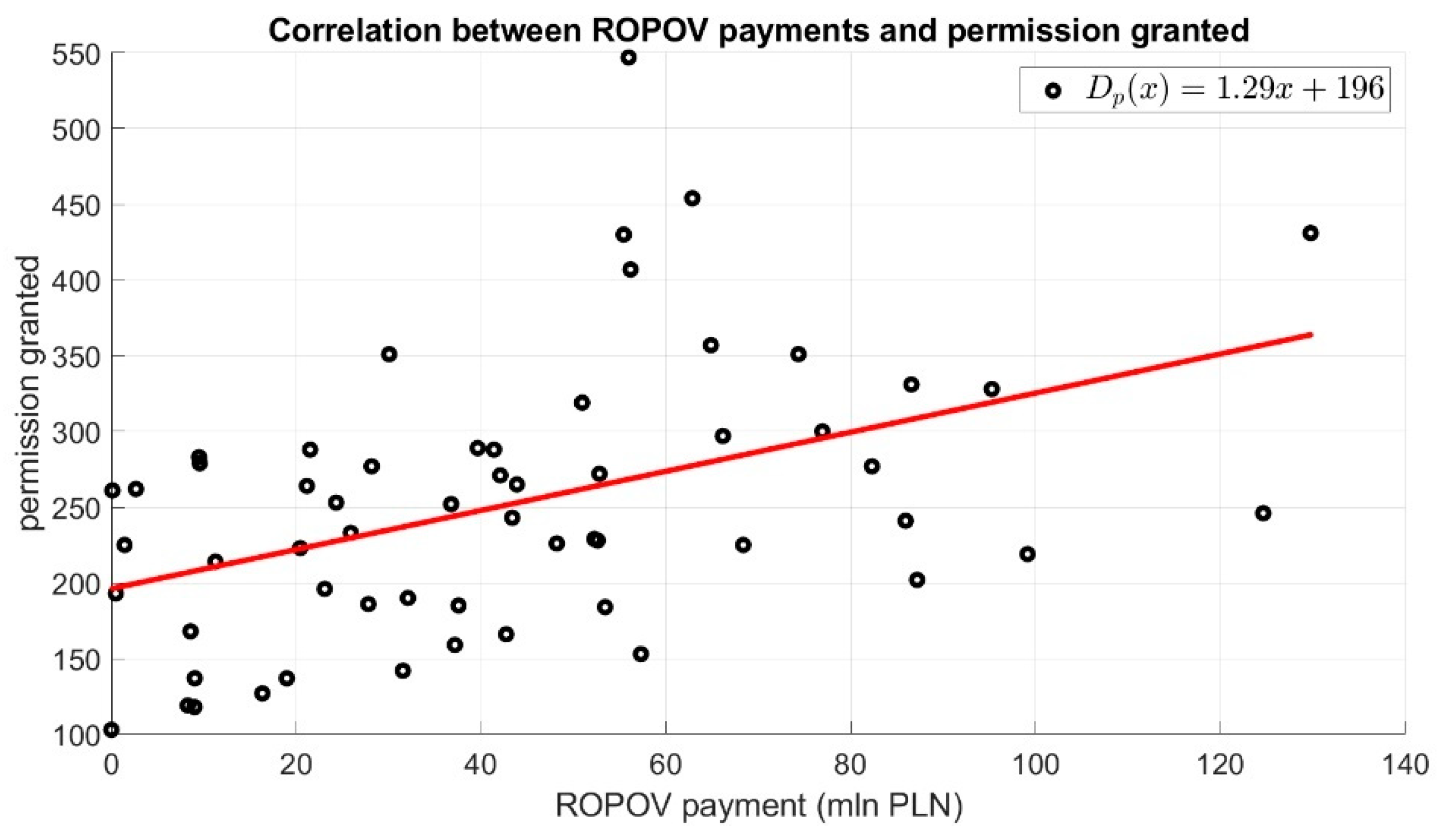
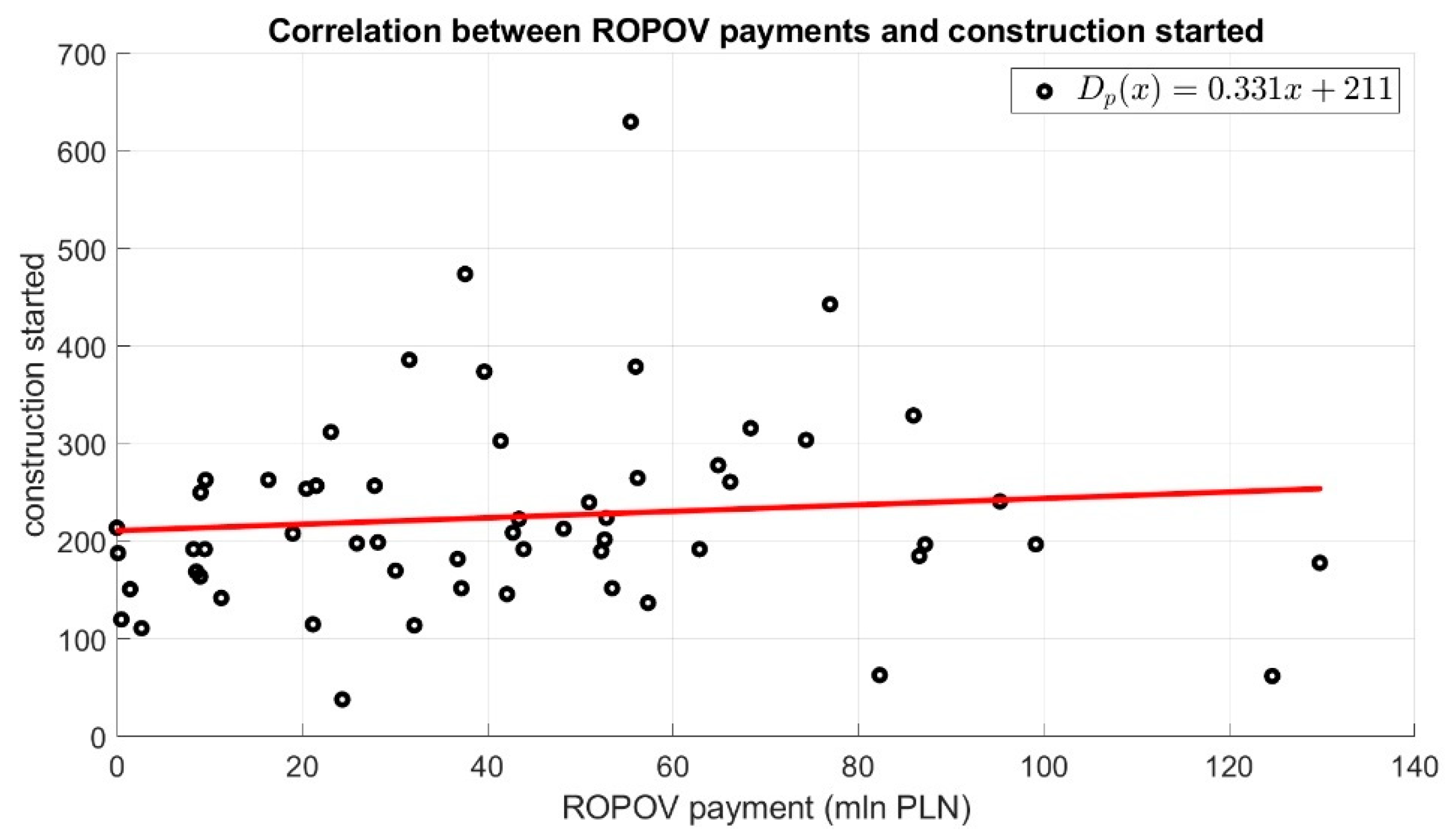
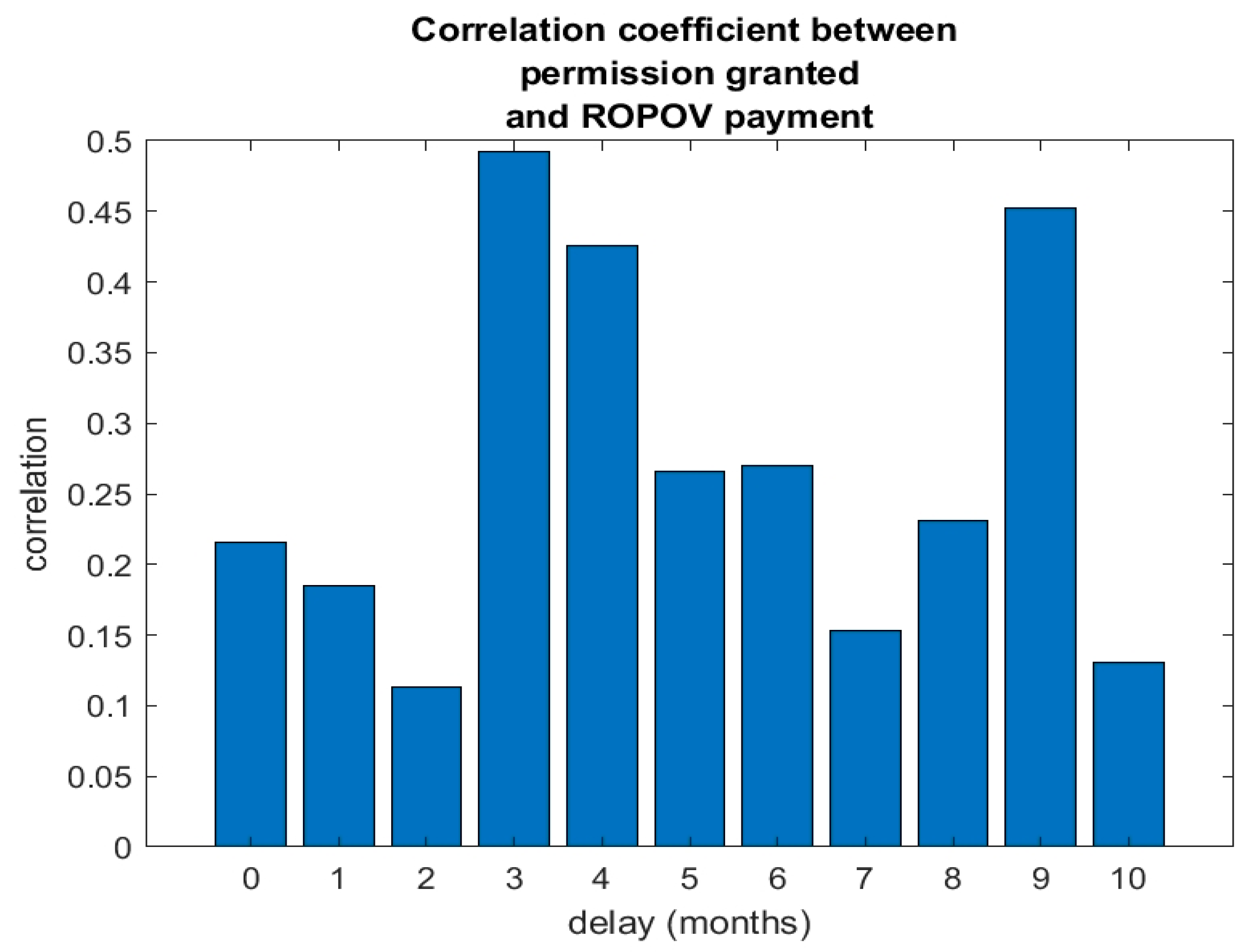
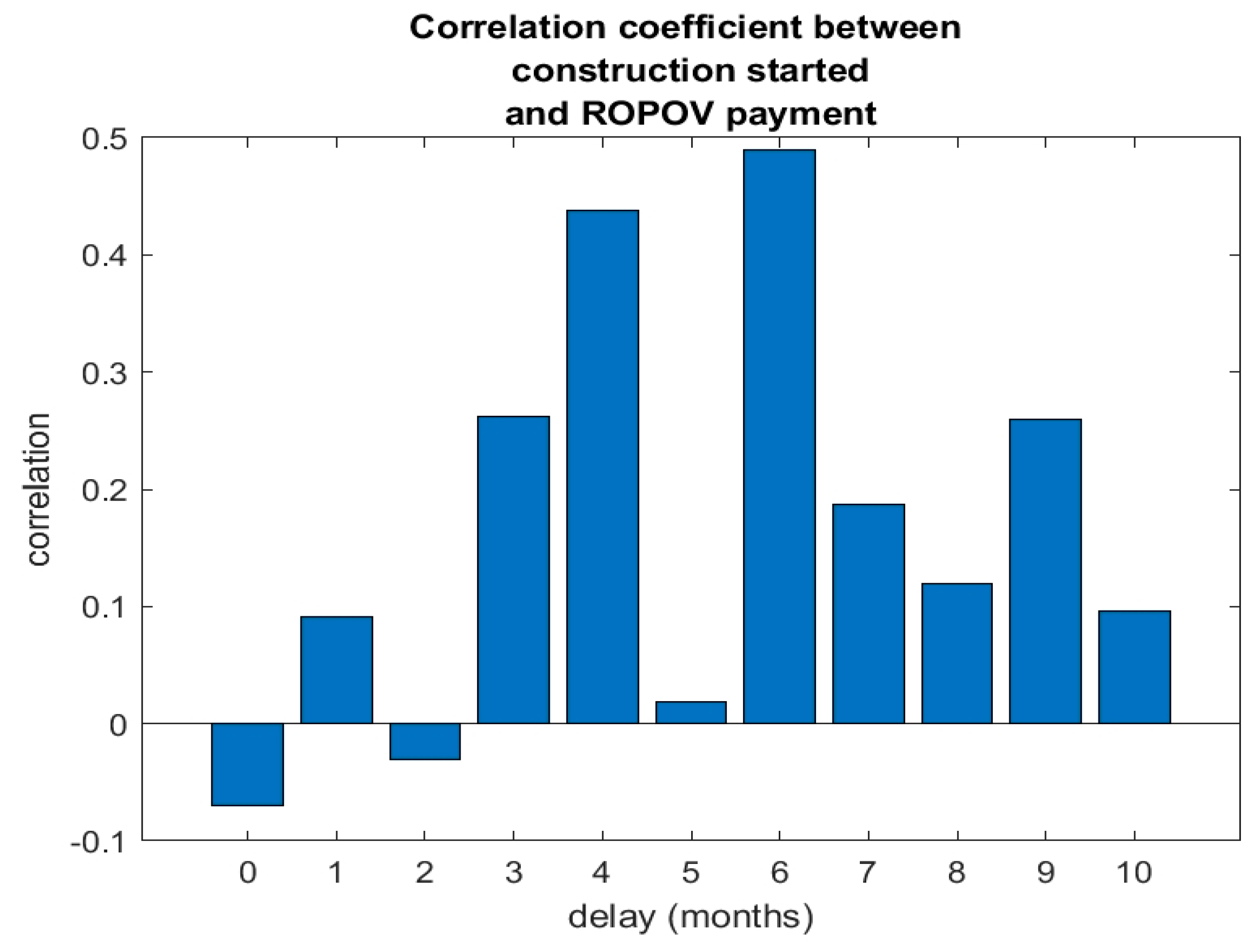

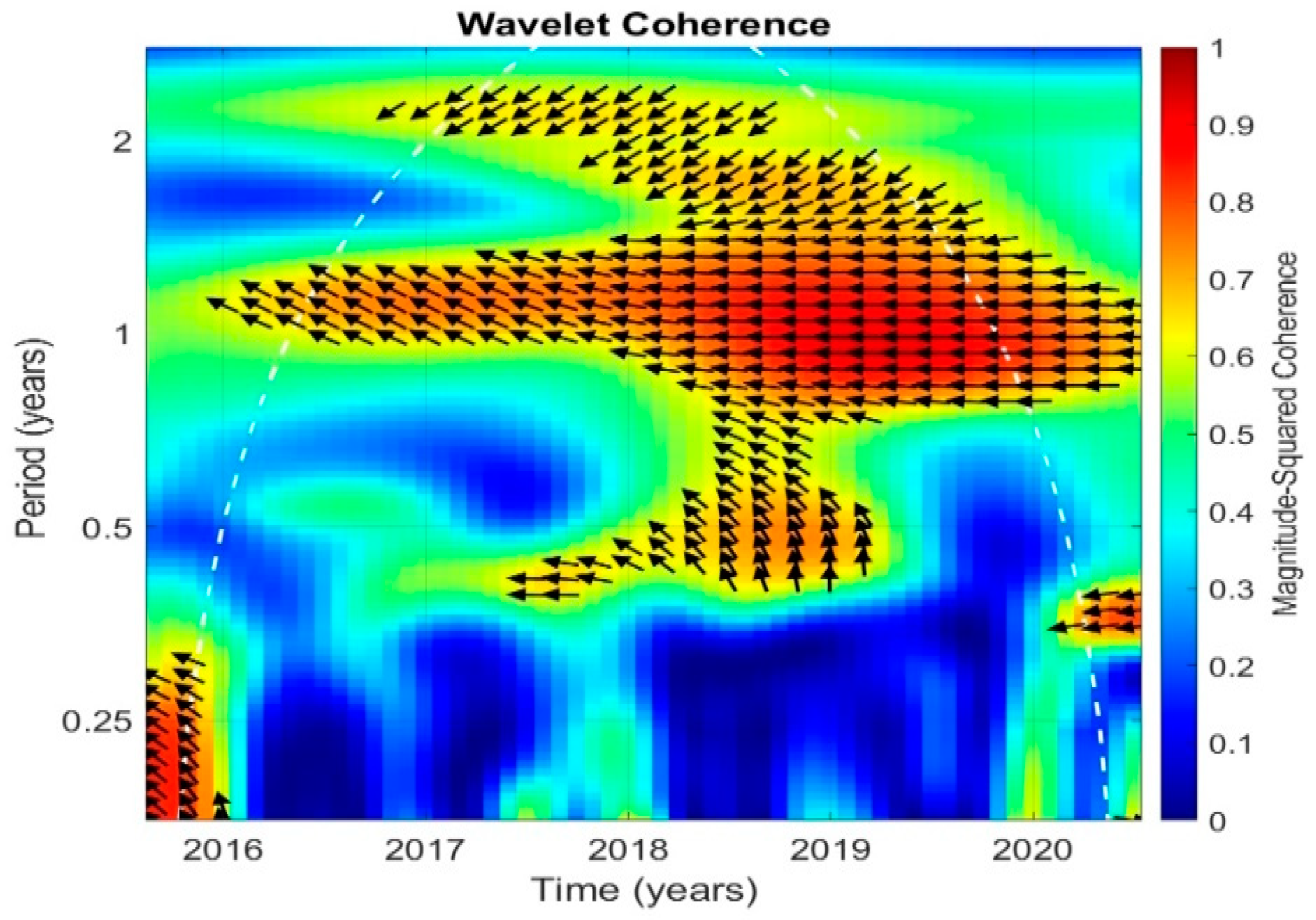
| Analyzed Variable | Mean | Median | Std | Min | Max |
|---|---|---|---|---|---|
| Permission granted | 250 | 243 | 89 | 103 | 547 |
| Construction started | 222.4 | 199 | 104 | 38 | 630 |
| ROP OV payment | 46.85 | 41.3934 | 42 | 0 | 269 |
| Estimate | SE | t-Stat | p-Value |
|---|---|---|---|
| 196.17 | 18.25 | 10.75 | 3.15493 × 10−15 |
| 1.29 | 0.34 | 3.73 | 0.000441825 |
| Estimate | SE | t-Stat | p-Value |
|---|---|---|---|
| 210.93 | 27.28 | 9.06 | 1.44817 × 10−12 |
| 0.33 | 0.44 | 0,75 | 0.456307637 |
Publisher’s Note: MDPI stays neutral with regard to jurisdictional claims in published maps and institutional affiliations. |
© 2021 by the authors. Licensee MDPI, Basel, Switzerland. This article is an open access article distributed under the terms and conditions of the Creative Commons Attribution (CC BY) license (https://creativecommons.org/licenses/by/4.0/).
Share and Cite
Mach, Ł.; Bedrunka, K.; Kuczuk, A.; Szewczuk-Stępień, M. Effect of Structural Funds on Housing Market Sustainability Development—Correlation, Regression and Wavelet Coherence Analysis. Risks 2021, 9, 182. https://doi.org/10.3390/risks9100182
Mach Ł, Bedrunka K, Kuczuk A, Szewczuk-Stępień M. Effect of Structural Funds on Housing Market Sustainability Development—Correlation, Regression and Wavelet Coherence Analysis. Risks. 2021; 9(10):182. https://doi.org/10.3390/risks9100182
Chicago/Turabian StyleMach, Łukasz, Karina Bedrunka, Anna Kuczuk, and Marzena Szewczuk-Stępień. 2021. "Effect of Structural Funds on Housing Market Sustainability Development—Correlation, Regression and Wavelet Coherence Analysis" Risks 9, no. 10: 182. https://doi.org/10.3390/risks9100182
APA StyleMach, Ł., Bedrunka, K., Kuczuk, A., & Szewczuk-Stępień, M. (2021). Effect of Structural Funds on Housing Market Sustainability Development—Correlation, Regression and Wavelet Coherence Analysis. Risks, 9(10), 182. https://doi.org/10.3390/risks9100182








